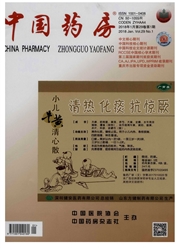

 中文摘要:
中文摘要:
目的:研究氢溴酸樟柳碱对急性脑缺血再灌注损伤模型大鼠脑组织细胞凋亡及细胞外信号调节蛋白激酶1/2(ERK1/2)磷酸化(p-ERK1/2)水平的影响.方法:将大鼠随机分为假手术组、模型组、阳性对照组(尼莫地平1.0 mg/kg)和氢溴酸樟柳碱高、中、低、极低剂量组(1.2、0.6、0.3、0.15 mg/kg),每组8只,采用线栓法建立大鼠急性脑缺血再灌注损伤模型.分别于脑缺血2 h和再灌注6 h时对各组大鼠尾iv给药1次,再灌注22 h后检测各组大鼠脑组织三磷酸腺苷(ATP)酶活性、Ca2+含量、细胞凋亡情况、脑组织中p-ERK1/2蛋白表达和p-ERK1/2/总ERK1/2(t-ERK1/2)比例.结果:与假手术组比较,模型组大鼠脑组织ATP酶活性明显降低、Ca2+含量明显增加、凋亡细胞密度明显增加,以上差异均有统计学意义(P〈0.01).与模型组比较,各给药组大鼠脑组织凋亡细胞密度均明显减小,阳性对照组和氢溴酸樟柳碱高、低剂量组大鼠脑组织Ca2+含量均明显降低,氢溴酸樟柳碱高、低、极低剂量组大鼠脑组织中p-ERK1/2/t-ERK1/2比例均明显增加,以上差异均有统计学意义(P〈0.05或P〈0.01);其余差异均无统计学意义(P〉0.05).结论:氢溴酸樟柳碱能抑制急性脑缺血再灌注损伤模型大鼠脑组织细胞凋亡,其作用机制可能与激活ERK1/2信号通路和调节ATP酶活性,进而降低脑组织Ca2+含量有关.
 英文摘要:
英文摘要:
OBJECTIVE:To study the effects of anisodine hydrobromide on cell apoptosis and extracellular signal-regulated pro-tein kinase 1/2 (ERK1/2) phosphorylation (p-ERK1/2) level in brain tissue of model rats with acute cerebral ischemia-reperfusion injury. METHODS:Rats were randomly divided into sham operation group,model group,positive control group(nimodipine 1.0 mg/kg),anisodine hydrobromide high-dose,medium-dose,low-dose,extreme low-dose groups(1.2,0.6,0.3,0.15 mg/kg),8 in each group. Suture method was used to establish the rat models with acute cerebral ischemia-reperfusion injury. Rats were intrave-nously injected once in tail at 2nd of ischemia and 6th of reperfusion. Then adenosine triphosphate (ATP) enzyme activity,Ca2+content,cell apoptosis in brain tissue,p-ERK1/2 protein expression in brain tissue,and p-ERK1/2/total ERK1/2 (t-ERK1/2) pro-portion in brain tissue of rats were detected after 22 h of reperfusion. RESULTS:Compared with sham operation group,ATP en-zyme activity in brain tissue of rats in model group was obviously decreased,Ca2+ content was obviously increased,density of cell apoptosis in brain tissue was obviously increased,with statistical significances(P〈0.01). Compared with model group,density of cell apoptosis in brain tissue was obviously decreased in each administration group;Ca2+ contents in brain tissue of rats in positive control group,anisodine hydrobromide high-dose,low-dose groups were obviously decreased;and p-ERK1/2/t-ERK1/2 proportion in brain tissue of rats in anisodine hydrobromide high-dose,low-dose,extreme low-dose groups were obviously increased,with sta-tistical significances(P〈0.05 or P〈0.01);the other differences were not statistically significant(P〉0.05). CONCLUSIONS:An-isodine hydrobromide can inhibit the cell apoptosis in brain tissue of model rats with acute cerebral ischemia-reperfusion injury,andthe mechanism may be related with activating ERK1/2 signal pathway and regulating ATP enzyme activity to decrease the
 同期刊论文项目
同期刊论文项目
 同项目期刊论文
同项目期刊论文
 期刊信息
期刊信息
